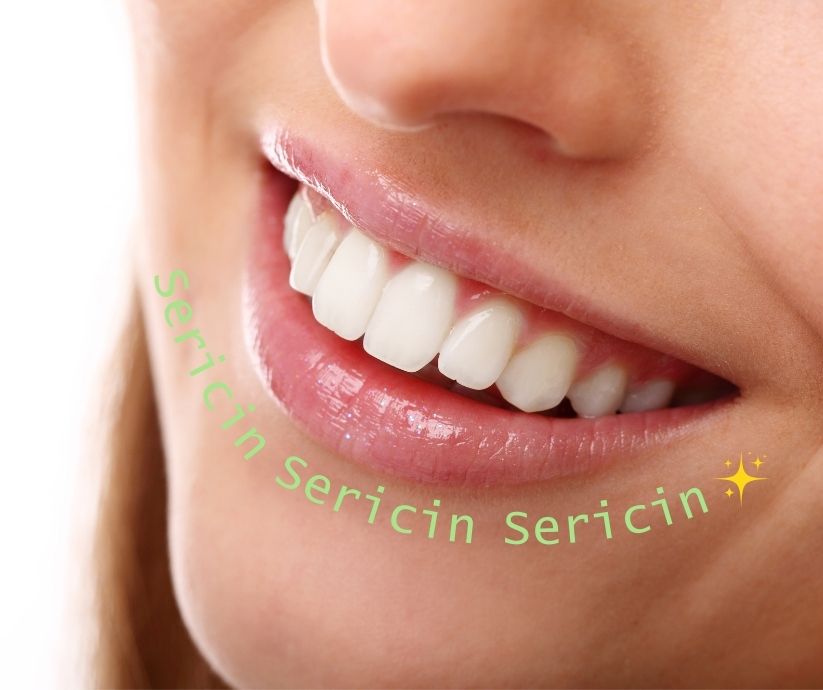The dental interest in sericin stems from its ability to act as a biomimetic scaffold for calcium phosphates and to cooperate with hydroxyapatite in biocompatible composites. In the dental field, this translates into three applications: functional coatings for implants and instruments, vehicles for local release of ions and active molecules in the oral cavity, and co-matrices for remineralizing pastes and gels. The literature on sericin/CaP shows that the polypeptide, rich in carboxylic and hydroxyl groups, guides HAp growth along the c-axis under physiological conditions, enabling films and particles with biomimetic morphology and good cytocompatibility. Research indicates strong interest in orthopedic and dental coatings to improve osseointegration, while recognizing the mechanical limitations of pure sericin and therefore the opportunity to use it as a component of coatings and particulates, not as bulk load-bearing material. In parallel, sericin-HAp obtained through biomimetic mineralization supports the viability and osteodifferentiation of periodontal ligament stem cells, a relevant finding for periodontal regeneration and biological dialogue around implant interfaces and restorations.
Enamel remineralization and molecular mechanisms
Sericin induces heterogeneous nucleation of hydroxyapatite when it presents high molecular weight and β-sheet conformation. Under such conditions, the periodic alignment of carboxylic groups generates induction sites for CaP in metastable solutions, with deposition of crystals similar to those of hard tissues. This molecular rationale is central in dentistry because enamel remineralization requires controlled nucleation and growth of HAp within micro-defects in the salivary environment.
The most advanced clinical-preclinical evidence on enamel remineralization today concerns nano-HAp, which demonstrates the ability to repair initial lesions and micro-erosions at least comparable to fluoridated solutions in pediatric models. Sericin, acting as a template or binder for CaP/ACP, is a natural candidate to anchor and orient such mineral phases on enamel and the acquired pellicle, improving their retention and crystalline organization. Although specific intraoral trials on dental sericin as an autonomous remineralizing active agent are still lacking, the corpus of data on sericin/CaP and the understanding of nucleation mechanisms justify its integration as a co-matrix in systems based on HAp and stabilized amorphous phosphate.
Bacterial biofilms and antimicrobial protection of the oral cavity
Regarding the antimicrobial component, the most stringent data in the cariogenic field is the antibiofilm activity of sericin against Streptococcus mutans. In vitro, sericin extracts obtained with different degumming methods reduce biofilm formation and cellular adhesion of S. mutans, with more marked performance for the urea-extracted fraction. The absence of cytotoxicity under the adopted experimental conditions has been verified in parallel. These effects, combined with sericin's marked hydrophilicity, have practical implications for surface conditioning. Therefore, more hydrophilic surfaces with adequate ζ potential reduce primary adhesion of S. mutans and biofilm maturation on dental materials, and the inclusion of sericin in films and coatings can contribute to shifting these parameters in favor of the host. On a broader level, updated research reports sequence-dependent antioxidant and antibacterial properties for sericin related to extraction processes, elements useful for modulating mucosal oxidative stress and microbial competition in plaque.
Design of mucoadhesive systems
The film-forming quality and the presence of polar amino acids make sericin intrinsically mucoadhesive, a key characteristic for increasing the residence time of active agents in the oral cavity without resorting to synthetic polymers. Cross-domain evidence shows that silk derivatives, including sericin, function as mucoadhesive matrices for local drug delivery on mucous membranes. Recent works present κ-carrageenan/sericin mucoadhesive beads for prolonged oral administration, confirming that the protein can be processed into systems that adhere and gradually release contents in the salivary environment. In dentistry, this translates into in situ gelling mouthwashes, topical gels, and varnishes where sericin performs three synergistic roles: promoting anchoring to the mucosa and pellicle, delivering CaP/ACP clusters or nano-HAp toward exposed enamel, and offering a hydrating barrier with potential antioxidant effect in mild gingivitis and mucositis.
Safety of use depends on purity. While raw silk could induce reactions, extracted and purified sericin is reported as biocompatible in multiple models, an essential point for natural formulations oriented toward daily use.
Clinical and research implications
The most realistic path for dental sericin is as a functional co-matrix in known remineralizing and protective systems, rather than as a unique principle. In prevention protocols, a formulation combining nano-hydroxyapatite with sericin designed in β-sheet conformation and adequate molecular weight could maximize nucleation and retention on the enamel surface. In periodontal and prosthetic protocols, thin sericin/HAp coatings on titanium components or indirect restorations can certainly contribute to modulating tissue response and early microbial colonization, provided the mechanical stability constraint of the coating is respected.
The next experimental steps, useful before clinical transfer, include in situ studies on human enamel surfaces with endpoints of surface hardness and micromorphology, diurnal plaque evaluations in crossover on sericin mouthwashes/gels, and rheological-mucoadhesive characterization in artificial saliva. The mechanistic and in vitro framework is already convincing, but intraoral validation will be decisive for defining doses, frequencies, and indications for use alongside or as an alternative to fluorides and HAp.


